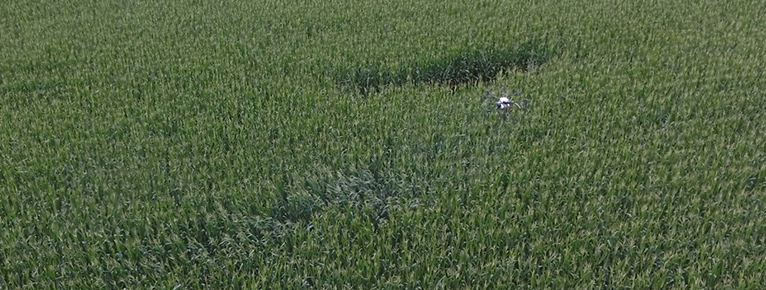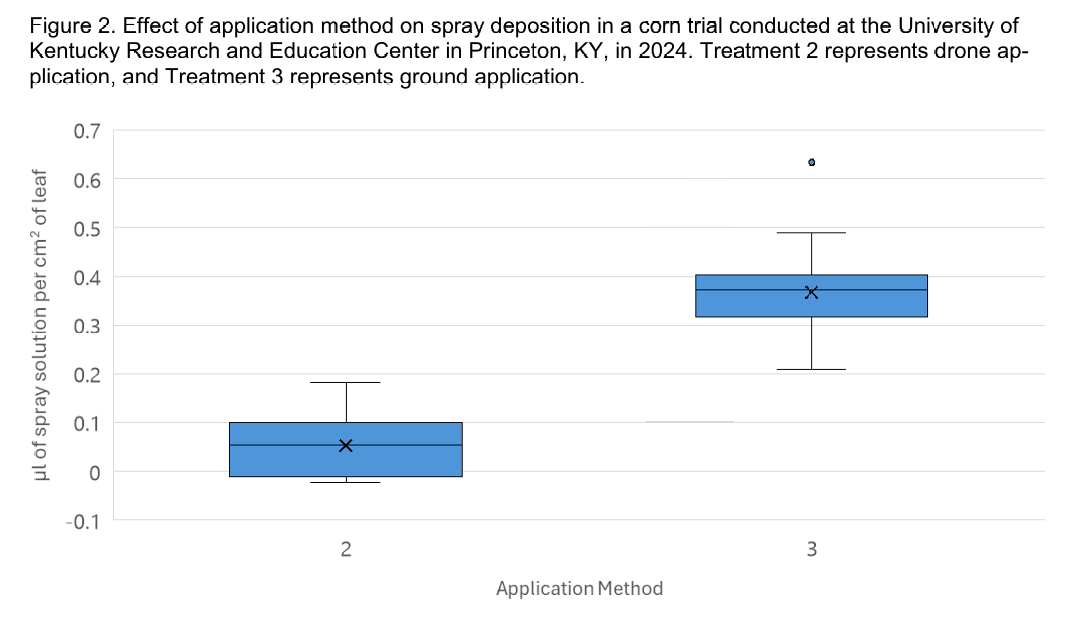Ground-Truthing Drone Fungicide Efficacy
Ground-Truthing Drone Fungicide Efficacy

Kiersten Wise, Tim Stombaugh, Will Barlow
University of Kentucky Research and Education Center, Princeton
University of Kentucky, Lexington
First published in the 2024 UK Corn Research Report.
INTRODUCTION (objective)
Unmanned aerial vehicle (UAV or drone) fungicide applications have become more common in Kentucky, allowing farmers who may not have access to high-clearance or aerial applicators to apply fungicides to corn. On-farm research initiated by the University of Kentucky in several counties has indicated that foliar fungicides applied by a drone at VT/R1 can effectively manage gray leaf spot in corn when using recommended spray carrier volumes. However, drone fungicide applications are anecdotally described by some as the “third-best option” behind fixed-wing or helicopter aerial application methods and high-clearance ground application, despite limited evidence of those claims. There are also questions about optimizing the swath width (spray width) of drones to prevent gaps in coverage on the edges of applications. Maximum swath widths are provided for each type of drone, but there is limited replicated research data on the reliability of these recommendations. Preliminary research from our program comparing drone vs. ground fungicide applications did indicate that both application methods provided similar levels of disease control and yield response. However, disease pressure was low in these trials. Understanding how drone fungicide application parameters affect disease development will aid farmers in setting up their own drones and improve commercial applicator efficacy by providing optimized settings for application. The specific objectives of this research were to 1) compare fungicide spray coverage, deposition, and efficacy of high-clearance ground applications to drone fungicide applications, and 2) determine the impact of spray parameters on drone sprayer swath coverage for fungicide applications.
METHODS & MATERIALS
Research trials were established at the University of Kentucky Research and Education Center in Princeton, KY in 2024. In each trial, the spray solution consisted of the fungicide prothioconazole + trifloxystrobin + fluopyram (Delaro Complete; 8 fl oz/A), non-ionic surfactant (0.25% v), 1,3,8-pyrenetetrasulfonic acid (PTSA; 600 ppm), and basic violet dye 10 or acid blue 009 (1% v/v) applied to corn at tasseling/silking (VT/R1) using a DJI T-10 drone or a ground sprayer. Experimental plots were eight rows (20 ft) by 70 ft in length and treatments in each trial were replicated four times in a randomized complete block design. To compare the effect of spray application method on fungicide efficacy, the fungicide spray solution was applied to experimental plots via drone or ground application methods using carrier volumes of 2.5 and 15 gallons per acre (gpa), respectively. A non-fungicide-treated control was included in this experiment. Fungicide coverage was determined by measuring the percentage of violet or acid blue dye coverage on ten phytochrome spray cards per plot using image scanning and processing software. Fungicide spray solution deposited in the canopy was collected by rinsing selected leaves with isopropyl alcohol immediately after application and measuring isopropyl/PTSA mixture for fluorescence using a fluorometer. Three measurements were obtained per leaf and compared to a calibration curve. Leaf area of collected leaves was measured, and fungicide deposition was verified by calculating the µl/cm2 of spray solution deposited from five leaves per plot. Preliminary experiments were conducted to determine the impact of spray parameters on swath coverage. The DJI-T10 applied a spray solution of water + acid blue 009 at 1% v/v over 3-inch bond paper stretched across a 50-ft section of ground. The spray coverage on the bond paper was analyzed using a Swath GobblerTM (Application Insight, LLC), which determined that at most application speeds and heights, a 10-ft swath width was appropriate for the drone model used in the experiment. Based on these results, we examined whether this swath width remains consistent in the corn canopy at four different spray parameters and a carrier volume of 2.5 gpa (Table 1). To measure spray deposition and coverage across the swath in the corn canopy, spray cards and leaf samples were collected from the ear leaf or ear + 1 leaf across a 15-ft swath in the center of each experimental plot. Each card and leaf were labeled by position in the plot and along the width of the swath to determine if spray deposition or coverage were greater at any point along the length of the spray swath (Figure 1).

Spray coverage and deposition for samples were measured as described above. For both trials, percent foliar disease severity on the ear leaf was rated for 10 plants per plot at dough (R4). Data were analyzed using mixed model analysis of variance in SAS (v. 9.4, Cary, NC) and treatment means separated using least square means.
RESULTS & DISCUSSION
Spray deposition was greater with high-clearance ground spray applications compared to drone applications (Figure 2). Spray parameters influenced spray coverage (Table 1), with lower spray coverage observed in treatments with higher flight speeds. Spray deposition and spray coverage were greater on one edge of each treated plot, indicating that spray movement may occur within each treatment, even though wind speeds were at or lower than 4.4 mph during application (Figure 3). Drought conditions in June delayed disease onset and development, and dry conditions persisted through August and September, limiting disease development. Gray leaf spot and southern rust were present at less than 1% disease severity, which limits the ability to determine the effect of application method and spray parameters on foliar disease control.


CONCLUSION
- Although ground application of fungicide resulted in greater spray coverage and deposition compared to drone application, its impact on controlling foliar diseases remains uncertain. In other research trials within this program, drone applications have demonstrated similar effectiveness in reducing gray leaf spot as ground applications. However, further research is needed to confirm these findings.
- Drone fungicide applications at higher speeds resulted in reduced spray coverage. Spray coverage and deposition were greater at one edge of the experimental plots throughout the experiment. This indicates spray movement occurred in all treatments, even under low wind speeds.
- Fungicide applications by drones are a viable way to apply fungicide in corn, but more research is needed to optimize the applications for disease control and yield benefits.
ACKNOWLEDGEMENTS
We gratefully acknowledge the Kentucky Corn Growers Association for funding this research, and the UKREC Farm Crew, Luke Warner, Nathan Hale, Jack Kocher, Catlin Young and Jacey Jaggers for assistance in establishing and maintaining the research and aiding data collection.
TABLES

